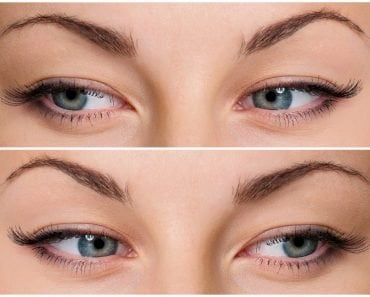Stripes are known to cause synchronous firing of neurons in visual regions of the brain, giving rise to gamma oscillations. This can cause discomfort or headaches in response to viewing stripes.
You wake up one morning, and while trying to pick your outfit for the day, your eyes fall on your favorite striped T-shirt. You spend a few seconds gazing at it as you mull over what to wear, but within a few moments, your eyes hurt and a throbbing sensation is felt in your temples. Does this situation sound familiar to you?

This is probably not new to you, as you might have felt it before while gazing at high-rise buildings with repetitive patterns, or even tile patterns on certain floors. Have you ever wondered why this happens? What goes “wrong” when you look at stripes or similar patterns that you end up with a headache or discomfort in your eyes? Let’s find out!
Recommended Video for you:
Differences Between Natural And Man-made Visual Stimuli
Our environment consists of diverse visual stimuli–both natural and man-made. However, the images or objects reported to cause discomfort to the eyes are almost always artificial or man-made in origin. Why is it that natural scenes and objects seldom elicit a similar discomfort in us?

The answer lies in the visual properties of these images/objects. Man-made objects have certain statistical properties that distinguish them from natural scenes and objects. Natural stimuli follow a certain rule in which contrast energy and spatial frequency are inversely related. This means that the visual system is only used to being presented with stimuli with inverse combinations of contrast energy and spatial frequencies, where one is high and the other is low. Man-made stimuli flout this rule, as some have high contrast energy at midrange spatial frequencies; these are the objects/images often reported to cause visual discomfort.
Processing Of Urban Stimuli By The Brain
A study looked at the brain metabolism of oxygen while participants viewed images—both natural and man-made/urban with various statistical properties. The farther an object was in terms of visual statistical properties, as compared to natural stimuli, the higher the rating of discomfort from participants. Furthermore, metabolic activity in the brain was also correlated with the degree of discomfort. Stimuli that caused the most discomfort were seen to cause a higher demand for metabolic activity in the visual areas of the brain.
This made it clear that stripes present statistical properties that are not naturally occurring, and also place ahigher metabolic demand on our brain, eliciting discomfort while viewing them.
Why Do Some Urban Stimuli Cause Headaches/migraine?
Scientists studied the human brain’s response to stripes to understand what in the brain is responsible for the discomfort. By using magnetoencephalography (MEG), they studied the brain activity of people while they viewed striped patterns of various frequencies. Interestingly, they found that viewing these patterns in certain frequencies induced gamma oscillations in visual regions of the brain, which coincided with the people reporting discomfort and illusions. The scientists reported that the occurrence of these oscillations may be responsible for the feeling of discomfort, dizziness, or even headaches/migraines in response to seeing stripes.
A recent study confirmed this suspicion, wherein researchers studied visual images and their probability of eliciting reactions in photosensitive epilepsy patients. In this investigation, they found that certain images had a higher probability of eliciting gamma oscillations in certain populations of neurons in the visual region of the brain. These same images also showed a higher risk of eliciting seizures in patients with photosensitive epilepsy.

This proved that the gamma oscillations are responsible for eliciting seizures in patients with epilepsy. These gamma oscillations, when elicited in the brains of neurotypical individuals viewing stripes, can cause headaches/migraines.
Conclusion
Certain urban stimuli containing stripes cause headaches or discomfort in viewers. These stimuli possess statistical properties that are distinct from other natural stimuli. These properties often place higher metabolic demands on the brain.
These patterns are known to cause synchronous firing of neurons in visual regions of the brain, giving rise to gamma oscillations. These oscillations are responsible for eliciting seizures in patients with epilepsy and are known to be the reason behind discomfort or headaches reported in response to viewing them. The discomfort in your eyes from viewing stripes is a result of the brain being faced with the problem of processing stimuli that do not naturally occur in our world. In many ways, it is similar to and as simple as your computer lagging in response to running software with which it isn’t compatible.
References (click to expand)
- Fernandez, D., & Wilkins, A. J. (2008, January 1). Uncomfortable Images in Art and Nature. Perception. SAGE Publications.
- Le, A. T. D., Payne, J., Clarke, C., Kelly, M. A., Prudenziati, F., Armsby, E., … Wilkins, A. J. (2017, April). Discomfort from urban scenes: Metabolic consequences. Landscape and Urban Planning. Elsevier BV.
- Adjamian, P., Holliday, I. E., Barnes, G. R., Hillebrand, A., Hadjipapas, A., & Singh, K. D. (2004, July). Induced visual illusions and gamma oscillations in human primary visual cortex. European Journal of Neuroscience. Wiley.
- Hermes, D., Kasteleijn-Nolst Trenité, D. G. A., & Winawer, J. (2017, May). Gamma oscillations and photosensitive epilepsy. Current Biology. Elsevier BV.












